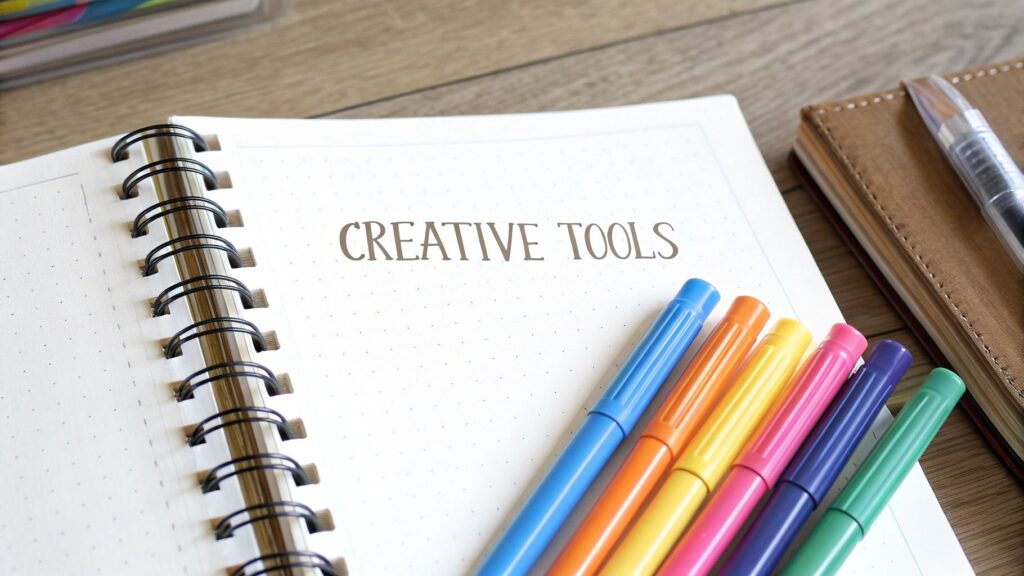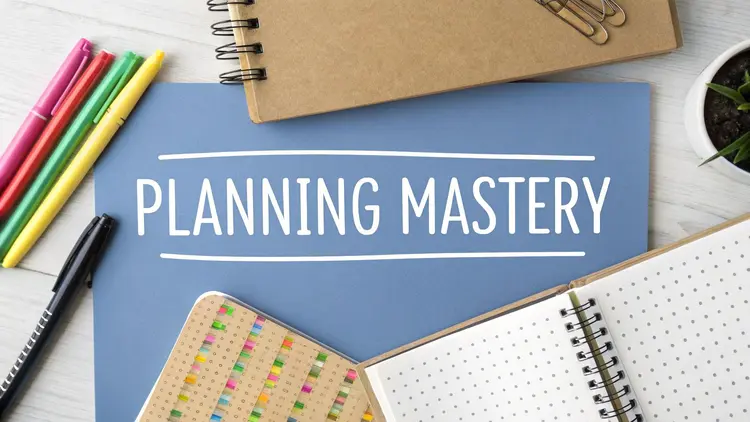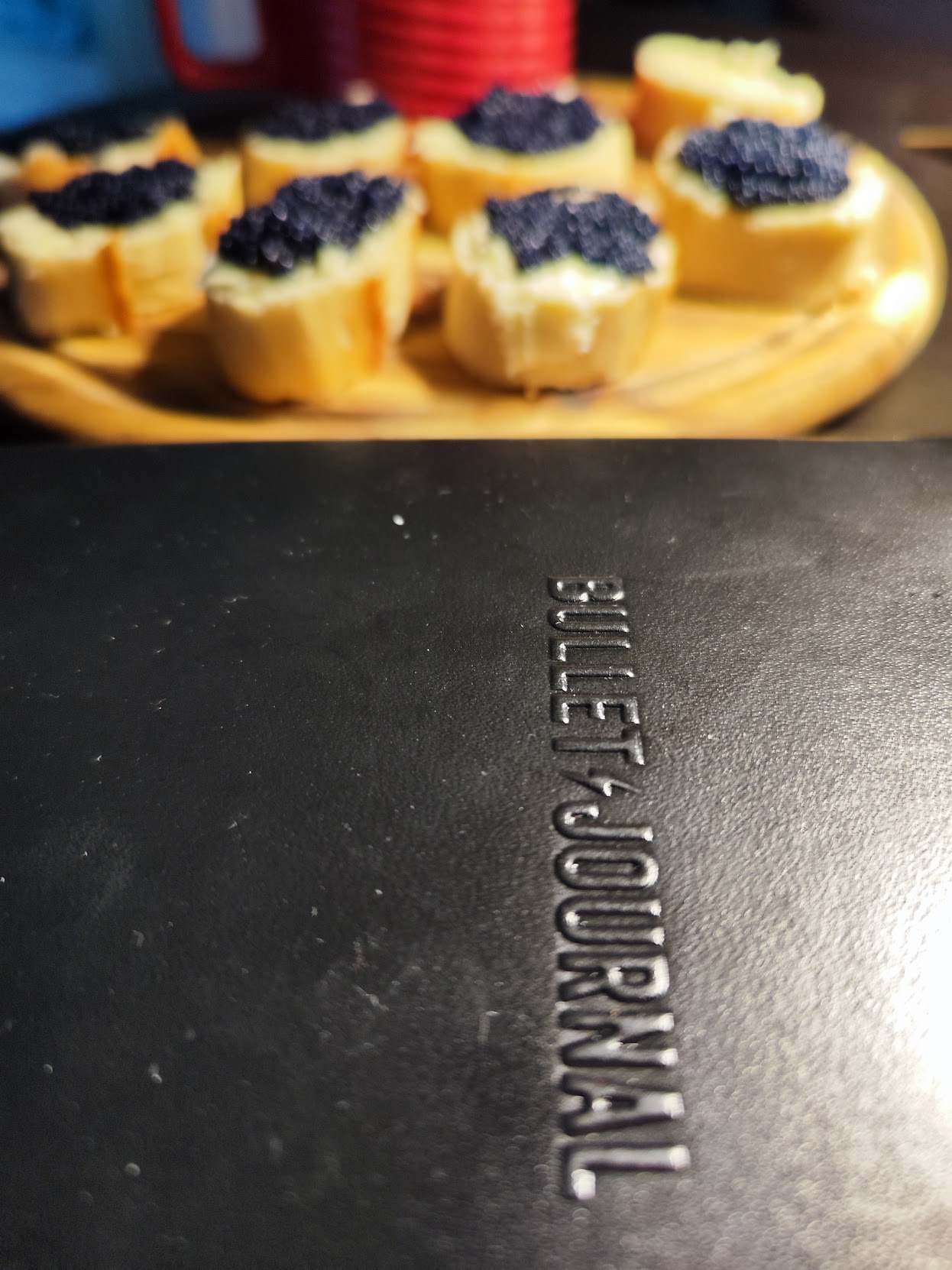Starting a bullet journal doesn’t have to be complicated. While there are lots of supplies out there, you really only need a few key items to get going.
Let’s look at what’s truly essential versus what’s nice to have, so you can start planning without getting overwhelmed by shopping.

Must-Have Supplies
The heart of bullet journaling comes down to three basic tools:
- Notebook: Pick a notebook that feels right to you. Many people love dot grid notebooks because they work well for both structured layouts and creative designs.
- Pen: Find a pen that writes smoothly and feels good in your hand. Test out different types like gel pens, ballpoints, or fineliners to see what works best.
- Ruler: A simple ruler helps create clean lines for layouts, calendars, and dividers – keeping everything neat and organized.
These three items are all you need to start an effective bullet journal. The notebook gives you space to plan, the pen lets you write down your ideas, and the ruler helps keep everything tidy. For more supply ideas, check out Everything You Need for Your Bullet Journal.
Enhancing Your Bullet Journal Experience: Optional Tools
While the basics work great, these extra items can make journaling more fun and personal:
- Colored Pens/Markers: Great for color-coding and adding creative touches
- Washi Tape: Perfect for decorative borders and dividers
- Stencils: Helpful for drawing shapes and lettering
- Stickers: An easy way to add personality to your pages
Remember – these extras are fun but not required. Focus first on making your journal work well for you.
Essential vs. Optional Supplies
Here’s a simple breakdown of what you need versus what’s nice to have:
| Essential Items | Optional Items | Estimated Cost |
|---|---|---|
| Notebook | Colored Pens/Markers | $10 – $30 |
| Pen | Washi Tape | $5 – $15 |
| Ruler | Stencils | $5 – $15 |
| Stickers | $5 – $10 |
As you can see, starting a bullet journal is pretty affordable. Many supplies can be found at discount stores or repurposed from items you already have. The trend has grown so much that notebook sales hit $210 million in 2018 – an 18 percent jump from the previous year. You can read more about these trends here.
Start simple and add tools as you go. This lets you develop a system that truly works for you while keeping the focus on planning and organizing rather than collecting supplies.
Mastering Your Bullet Journal Foundation

Setting up a bullet journal is like building a house – you need a strong foundation before adding all the decorative elements. Let me guide you through the essential pieces that make up an effective bullet journal system. This will help you build a framework that fits your needs perfectly. For more inspiration, check out how to organize your life with a bullet journal.
Understanding the Key Components
While bullet journaling is wonderfully flexible, there are some basic elements that help create structure. Here are the main building blocks you’ll want to include:
- Index: Works like a table of contents to help you find your collections quickly
- Future Log: Your bird’s-eye view of upcoming events and tasks
- Monthly Log: A snapshot of your current month’s schedule and to-dos
- Daily Log: Where you track tasks and notes as each day unfolds
These pieces work together naturally. For example, you might jot down a doctor’s appointment in your future log, move it to your monthly log when the time comes, then add it to your daily log on the actual appointment day.
Setting Up Your Index
Think of your index as the roadmap to your bullet journal. Reserve the first few pages for it, then add page numbers and titles as you create new sections. This simple step makes finding information so much easier later on.
Building Effective Collections
Collections are dedicated pages for specific topics or projects in your bullet journal. Keep them focused on what matters most to you. Some popular collection ideas include:
- Brain Dump: A space to clear your mind of random thoughts and ideas
- Habit Tracker: Keep tabs on building positive routines
- Goal Setting: Map out your short and long-term aims
- Project Planning: Break big projects into smaller, doable steps
Maintaining Your System: The Migration Process
Regular review and migration keeps your bullet journal useful and relevant. Most people use their bullet journals by first creating an index, then adding collections like monthly and daily logs. You’ll use simple bullets and symbols to mark tasks and notes, moving items between collections each month. To see different setup styles, visit this bullet journal guide.
At the end of each month, look through your tasks. Move unfinished items to next month, schedule them for later, or decide if they’re still worth doing. This helps prevent your journal from getting cluttered with old tasks while keeping you focused on what’s truly important.
By understanding and consistently using these basic elements, your bullet journal can become an amazing tool for staying organized and achieving your goals.
Designing Monthly Spreads That Actually Work

Ready to take your bullet journal to the next level? Let’s explore how to create monthly spreads that help you stay organized and focused. A good monthly spread gives you a clear view of your schedule while looking beautiful too. I’ll show you how to strike that perfect balance between practicality and personal style.
Choosing the Right Monthly Layout
Finding your ideal layout takes some trial and error. Here are three proven options to consider:
- Calendar Layout: Perfect for visual planners who want to see their whole month at a glance. Great for tracking appointments and deadlines.
- List Layout: Ideal if you prefer organizing tasks in a straight-forward list format. Makes it easy to prioritize what needs to get done.
- Combination Layout: Get the best of both worlds by mixing calendar and list elements. You’ll have a visual overview plus detailed task management.
Incorporating Habit Tracking and Goal Setting
Add habit trackers and goal setting sections to make your monthly spread more meaningful. Track things that matter to you – maybe it’s exercise, reading, or drinking more water. Write down 2-3 clear goals for the month to stay motivated and feel accomplished when you achieve them.
Maximizing Your Monthly Spread’s Potential
Want more spread inspiration? Check out our guide to How to Master Your Weekly Spread Design.

Make your monthly spread even better with these helpful elements:
- Mini Calendars: Add a small next-month calendar to plan ahead
- Brain Dump Area: Give yourself space to jot down random thoughts and ideas
- Reflection Space: Look back on your month – what went well? What could improve?
Troubleshooting Common Monthly Spread Challenges
Running into issues with your spread? Here’s how to fix common problems:
- Overcrowding: Use smaller writing or simple symbols to fit more in neatly
- Lack of Flexibility: Try a rolling weekly spread to easily adjust plans
- Loss of Motivation: Keep it simple and focus on what actually helps you stay organized
Remember – your bullet journal should work for you. Feel free to try different approaches until you find what clicks. The key is creating a system that helps you stay on track while feeling natural to use.
Weekly and Daily Systems for Peak Productivity
Now that you’ve got your monthly spreads down, let’s focus on the heart of your bullet journal: your weekly and daily systems. These are the key tools that help turn your goals into real action steps. Let’s explore how to set these up in a way that works best for you.
Choosing the Right Weekly Layout
Your weekly layout should match how you naturally plan and work. Here are some popular options to consider:
- Horizontal Layout: Uses rows for each day, giving you a clear view of your whole week at once. Perfect if you like seeing everything laid out in front of you.
- Vertical Layout: Sets up days in columns, making it easy to plan specific times and block out your schedule.
- Dutch Door Layout: Features a clever folded page design that shows both your weekly overview and daily details. Great for seeing the big picture while working on daily tasks.
Optimizing Your Daily Log
Your daily log keeps track of all the small but important details. Here’s how to make it work:
- Rapid Logging: Use simple bullets and symbols to quickly write down tasks, events and notes. This keeps everything clear and actionable.
- Prioritization: Mark your most important tasks clearly – you can use stars, highlights or any system that catches your eye. This helps you focus on what matters most.
- Time Blocking: Set aside specific chunks of time for different activities, including breaks. This creates a realistic schedule you can actually stick to.
Adapting Layouts for Different Schedules
Everyone’s schedule is unique. Here’s how to customize your journal to fit yours:
- For unpredictable schedules: Try a rolling weekly spread that lets you add tasks as they come up, without being tied to specific days.
- For project-focused work: Add project pages to your weekly spread to break big projects into smaller steps.
- For busy, on-the-go days: Use a minimalist daily log that focuses just on the essentials. Keep it simple but effective.
Managing Task Overflow and Habit Tracking
It’s normal for tasks to carry over from one day or week to the next. Here’s how to handle this smoothly:
- Migration: Review unfinished tasks regularly and move them forward. Don’t let important items slip through the cracks.
- Prioritize and Delegate: When your list gets too long, take a fresh look at what’s really important. Could someone else help with some tasks?
- Break Down Large Tasks: Turn big tasks into smaller, more doable steps. This makes them less overwhelming and easier to complete.
You might be interested in: How to Track Your Health & Fitness in Your Bullet Journal. Adding health tracking can help boost both your productivity and wellbeing.
Popular Layout Styles Comparison
Here’s a helpful comparison of different layout options to help you choose what works best:
| Layout Style | Best For | Time Investment | Flexibility |
|---|---|---|---|
| Horizontal | Visual weekly overview | Low | Moderate |
| Vertical | Detailed scheduling | Medium | Moderate |
| Dutch Door | Combining overview and details | Medium | High |
| Rolling Weekly | Unpredictable schedules | Low | High |
| Minimalist Daily | Busy, on-the-go lifestyles | Low | High |
When you create weekly and daily systems that match your needs, your bullet journal becomes a powerful tool for getting things done. Remember – the best system is the one that works for you, so feel free to adjust things as your needs change.
Creating Beauty Without Sacrificing Function

Your bullet journal is a personal space where both beauty and usefulness can coexist. While staying organized is the main goal, adding your own creative touches makes the experience more enjoyable. Finding this sweet spot between pretty and practical is key to sticking with your journal long-term.
Making It Your Own
The joy of bullet journaling comes from developing a style that feels authentic to you. You don’t need fancy lettering or complex artwork – it’s about finding simple elements that make you happy to use your journal. Some people love clean, minimal designs with straight lines, while others prefer bright colors and fun sketches. Try different approaches until you find what clicks.
Quick and Easy Decorative Ideas
You can make your journal look great without spending hours on decorations. Here are some simple ways to add visual interest:
- Washi Tape: Perfect for creating borders and dividers with zero artistic skill needed
- Stickers: Add instant personality and flair without drawing
- Color-Coding: Use different colored pens to organize and beautify at the same time
- Basic Doodles: Even simple shapes and lines can personalize your pages
These methods let you create an attractive journal without derailing your productivity. This balance is especially important when life gets busy.
Finding Your Sweet Spot
Remember that your bullet journal should help you plan and achieve your goals while still being a place for self-expression. Add creative elements that make you smile, but not at the expense of actually using your journal effectively. If decorating starts taking more time than planning, it might be time to simplify. The goal is a journal that works for your life.
Social media can create pressure to make picture-perfect spreads. Many popular bullet journal accounts showcase highly styled pages that may not be realistic for daily use. Don’t let this discourage you from creating a journal that serves your needs. Learn more about the impact of social media on bullet journaling here.
Staying Inspired When Creativity Runs Low
Even enthusiastic journalers hit creative dry spells sometimes. Here are ways to get back on track:
- Look for New Ideas: Check out Pinterest or Instagram when you need fresh inspiration
- Keep It Simple: Scale back to basics if you’re feeling overwhelmed
- Take a Short Break: Step away briefly to refresh your perspective
- Join the Community: Connect with other bullet journalists for support and motivation
Focus on creating a bullet journal that helps you stay organized while bringing you joy. The goal is to build a system that makes life easier, not more complicated.
Sustaining Your System for Long-Term Success
A bullet journal is more than just pretty layouts – it’s a dynamic system that grows with you. When you maintain and adapt it thoughtfully, that’s when the real benefits emerge. Let’s explore how to keep your bullet journal working well for years to come.
Building Resilient Routines
Making your bullet journal a consistent habit is essential. Think of it like tending a garden – it needs regular care to thrive. Set aside a dedicated 15 minutes each day for journaling, whether that’s planning in the morning or reflecting in the evening. Make it as natural as brushing your teeth. This simple routine will help you stay organized and focused on what matters.
Adapting to Changing Needs
Life throws curveballs, so your bullet journal should be flexible. Maybe you start a new job with different scheduling demands – your old layout might not work anymore. Feel free to try fresh layouts, trackers, or collections. This flexibility to adjust is what makes bullet journaling so useful. Want more tips? Check out How to master your daily planning with a bullet journal.
Troubleshooting Common Challenges
Even experienced bullet journalists hit roadblocks sometimes. Falling behind is a common issue.
Don’t stress if this happens – just look at what’s not working, make some tweaks, and start fresh. Sometimes switching to a simpler layout or fewer trackers does the trick. Another challenge is perfectionism. Remember, your journal is a tool to help you, not an art project. It’s perfectly fine if your handwriting or spreads aren’t Instagram-perfect.
Evolving Your System
Your bullet journal setup should change as your life does. What worked six months ago might not fit your needs now. Take time to review your system, spot areas for improvement, and make changes. Try a new weekly spread, add or remove collections, or simplify your key. These regular updates keep your journal useful and relevant.
Ready to take your organization skills further? Lorelei Web has tons of helpful resources for entrepreneurs, including tips on using bullet journals to improve your work and life. Visit Lorelei Web to learn more and discover new strategies.

Lorelei has been an online entrepreneur, marketer and writer since 2006. Her biggest passion is WordPress, which is why she switched to being a full-time blogger 20 years ago and hasn’t looked back since. With so many years of experience behind her, she is an expert in copywriting, SEO, marketing and business strategies.






